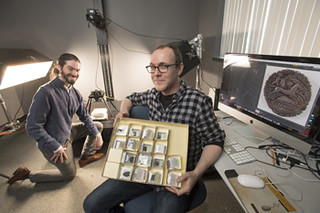
PREV ARTICLE
NEXT ARTICLE
FULL ISSUE
PREV FULL ISSUE
RUTGERS DIGITIZES ROMAN COIN COLLECTION
Rutgers University has announced the completion of a project to create digital images of Roman Republic coins in their collection. Thanks to Arthur Shippee for passing this along.
-Editor
The digitization of ancient coins is not some retro version of Bitcoin. Through a collaboration of classical scholarship and super high-resolution photography, the goal was to make multi-angle views of these coins – some of copper, some of bronze, silver or gold, all bearing fascinating engravings – available for study by scholars and students while protecting the originals. Anyone with an Internet connection can now zoom and pan all 1,250 digitized coins free of charge, via the Coins portal. Visitors to the Alexander Library at Rutgers University–New Brunswick can view several of the actual coins, along with reproductions of the new digital images, at an exhibit opening March 23 in the Scholarly Communication Center. The Badian Collection of Coins of the Roman Republic is named for Ernst Badian, the late Harvard University professor who donated the vast collection to Rutgers thanks to his connection to Brennan, who was his student. “The Libraries, the Classics Department and the School of Communication and Information all collaborated to make this happen,” said Ronald Jantz of the Shared User Services unit of the Rutgers University Libraries, who oversaw the digitization project along with Brennan. The bulk of the work was done by Rick Hale, a classics doctoral student in the School of Graduate Studies, four library school students from SC&I, and several part-time library employees. The digitization, description of the coins, and upload to Rutgers Institutional Repository (RUcore) spanned about four years and required patience, skill, knowledge of ancient coins, advanced technology and improvisation. “At first, showing multiple angles for each coin meant we had to manipulate them manually — shoot straight on, move the coin a few degrees, shoot that image, and so on,” Hale said. Although the multiple-angle approach did have some advantages, the Coins team switched to taking images of the obverse and reverse of each coin in order to expedite the imaging process. Late in the project, Aaron Hershkowitz, also a classics doctoral student, joined the team and brought with him a knowledge of a new technology “reflectance transformation imaging,” or RTI, with which Hale and Hershkowitz began to experiment toward the end of the project. In RTI, the coin is placed inside an LED-studded dome, making it possible to shoot multiple views by manipulating the lights, not the coin. The RTI technology holds great promise for continuing to improve the coin imaging process.
To read the complete article, see:

Wayne Homren, Editor The Numismatic Bibliomania Society is a non-profit organization promoting numismatic literature. See our web site at coinbooks.org. To submit items for publication in The E-Sylum, write to the Editor at this address: whomren@gmail.com To subscribe go to: https://my.binhost.com/lists/listinfo/esylum All Rights Reserved. NBS Home Page Contact the NBS webmaster 
|
